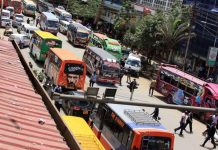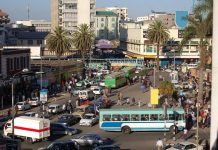The World Health Organisation says between 5,000 and 15,000 lives are lost on the roads every year, but Kenyan authorities peg the figures at about 3,000.
NTSA deputy director and head of road safety Duncan Kibogong told the Star these figures vary because the available data is collected on a daily basis by police on the crash site.
Kibogong said WHO, however, reports and collects data of these accidents after 30 days.
“They make a comprehensive follow-up on injuries, get data from hospitals and mortuaries,” he said.
An annual crime report by the Kenya National Police Service cited the major causes of these accidents as speeding, overloading, drunk driving, fatigue and wrong use of the road by pedestrians. Other factors were poor roads infrastructure and non-observance of traffic laws.
Some 5,188 cases of road accidents were recorded last year as compared to 4,456 cases in 2017. This, police said, was an increase of 732 cases, or 16 per cent. Out of the accidents, 2,613 were fatal, claiming 3,163 lives, compared to 2,358 fatal accidents that claimed 2,924 lives in 2017.
These accidents involved a total of 12,985 victims in 2018, as compared to 11,233 cases reported in 2017, which was an increase of 1,752 cases or 16 per cent.
This included 3,163 fatalities, 4,705 serious injuries and 5,117 slight injuries. Some 54 per cent of the victims were passengers, even though most of them sustained slight injuries.
The report indicated 38 per cent of those killed were pedestrians as a result of careless transportation by drivers and motorcyclists who were responsible for 59 per cent of these accidents.
Police said some Sh683,226,000 was collected as fines as compared to Sh661,585,138 in 2017, which was an increase of Sh21,640,862 or 3 per cent.
These figures, according to WHO, put Kenya among the world’s 20 most notorious countries with the highest number of road accidents.
Kibogong said every year, Kenya loses Sh350 billion, an equivalent of 5.6 per cent of its GDP, to traffic crashes.
He said since the target to reduce these crashes to 50 per cent by 2020 is not achievable, the figures are likely going to increase over the years.
Kibogong said road crashes are still on the rise across the country because existing laws on road safety are poorly enforced. This, he said, has provided loopholes that have led to a lack of a culture on which road safety can thrive.
“This is something that can be created if road users understand the cost of their actions or inactions both at the personal and national levels,” he said.
273 BLACK SPOTS
The National Transport and Safety Authority in its latest data indicates that as of November 12, some 3,053 people have died on the road.
Kibogong said pedestrians are leading the pack at 1,180 lives, followed by motorcyclists at 910, passengers are third at 609 lives, drivers at 290 lives and 64 peddle cyclists.
He said with regards to gender, more males are dying on the roads as compared to females. This, he said, is a clear indication that males are more exposed to the transport sector than female.
According to NTSA’s Northern Corridor report, launched in July last year, there are 273 black spots identified in the country.
Out of these, 199 spots an equivalent of 72 per cent are along the northern corridor, which runs from Mombasa to Malaba through Nakuru, Mau Summit, Jericho and Busia. This is a stretch of some 930km.
NTSA said there is heavy pedestrian and PSV traffic on the corridor with many undesignated bus stops. According to the authority, there are no road signs and most of the road is unmarked.
“Another aspect is the speeding motorists coupled with slippery sections, illegal turning to the opposite lanes and slow-moving trucks due to the hills,” reads part of the report.
Nairobi alone has 74 black spots, with seven spots identified from Bellevue Point on Mombasa Road to the Nairobi-Machakos county border.
Nairobi has connectivity of 360km of roads. Unsafe road user behaviour, inadequate infrastructure and missing road signage is to blame for the accidents.
Roads with the highest number of accidents are Thika Superhighway, Landhies Road, Haile Selassie, Eastleigh First Avenue, Juja Road, Jogoo Road, Lunga Lunga, Likoni, Kangundo and Eastern bypass.
Other roads the report indicates are North Airport Road, Enterprise, Southern bypass, Naivasha Road, Valley Road, Mbagathi Road, Langata Road, Limuru Road and Northern bypass.
SOURCE: the-star.co.ke








![Top 20 Used Cars to Avoid Buying in Kenya – [PHOTOS]](../../../blog/wp-content/uploads/2013/11/top-used-unreliable-cars-to-avoid2-80x60.jpg)

![Top 20 Used Cars to Avoid Buying in Kenya – [PHOTOS]](../../../blog/wp-content/uploads/2013/11/top-used-unreliable-cars-to-avoid2-100x70.jpg)





